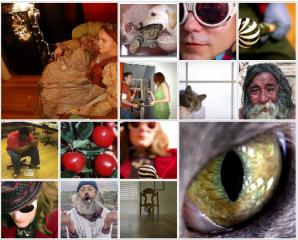Interactive Storyteller
Jong-Hwan Baek
My thesis project, Interactive Storyteller, is designed to create a more satisfying experience for user-generated, interactive storytelling.
http://imagetail.com/main

Whatever its form, much of today’s storytelling uses image in a variety of ways. Consider how movies, Flickr, television and the user-generated content on YouTube have changed the visual language of storytelling. Let’s imagine there are ten random images in front us, lined up in random order. If asked to make a story by assembling them into a narrative, could an average person in our visually-inspired culture do this? Will the story make sense? Probably yes. But images can tell only so much of a story. If we want to help them make the narrative more effective, we could add a more traditional storytelling tool: text. If they can now write text to each image, their story will make much more sense. Thus, by allowing people to combine images and text, they have the tools to create an image-driven story for modern tastes.
By keeping the image content simple, having the text content attached to each image, and allowing people to self-assign to their own groups, Interactive Storyteller seeks to maximize users’ collaborative ability while minimizing the incoherence resulting from other collaborative story processes.
Audience
My thesis project is for everyone interested in creating a story with other writers and has an interest in the unpredictable and surprising results of collaboration.
User Scenario
Let’s assume the initiating story group decides that their story will require seven images. User #1 submits one image and writes text for it. This sets the stage for the story. Then User #2, after seeing user #1’s image and text, submits another image with text to continue the story. The story can keep the direction User #1 has set, or change direction. The process continues through to User #7. After User #7 submits an image and text, the story is complete and ready to be viewed by the entire group as well as others on the website. Each User in the group can see the story developing as each story segment is uploaded. To sum up, User #1 does the set up for the story and Users #2 though #7 try to either follow the story set up or take the story in new, interesting direction.
Implementation
Building the website for Interactive Storyteller requires good programming and sensitive design. The structure and storyboards for the website were planned out first and then the design of the website followed. The interface is simple and (hopefully) intuitive for users as well. The components of the project are mainly twofold. One is the mechanism and database for storing images. The second is the mechanism and database for image assembly and text additions for creating a story.
Conclusion
This project has been successful in that those users who participated in the experience of interactive storytelling have expressed interest and enthusiasm stemming from the joy of creating stories with others online. For the first time, these users had the chance to collaborate on stories, both visually and in text form,that they never had before. For most, Interactive Storyteller was a unique experience.
By keeping the image content simple, having the text content attached to each image, and allowing people to self-assign to their own groups, Interactive Storyteller seeks to maximize users’ collaborative ability while minimizing the incoherence resulting from other collaborative story processes.
Audience
My thesis project is for everyone interested in creating a story with other writers and has an interest in the unpredictable and surprising results of collaboration.
User Scenario
Let’s assume the initiating story group decides that their story will require seven images. User #1 submits one image and writes text for it. This sets the stage for the story. Then User #2, after seeing user #1’s image and text, submits another image with text to continue the story. The story can keep the direction User #1 has set, or change direction. The process continues through to User #7. After User #7 submits an image and text, the story is complete and ready to be viewed by the entire group as well as others on the website. Each User in the group can see the story developing as each story segment is uploaded. To sum up, User #1 does the set up for the story and Users #2 though #7 try to either follow the story set up or take the story in new, interesting direction.
Implementation
Building the website for Interactive Storyteller requires good programming and sensitive design. The structure and storyboards for the website were planned out first and then the design of the website followed. The interface is simple and (hopefully) intuitive for users as well. The components of the project are mainly twofold. One is the mechanism and database for storing images. The second is the mechanism and database for image assembly and text additions for creating a story.
Conclusion
This project has been successful in that those users who participated in the experience of interactive storytelling have expressed interest and enthusiasm stemming from the joy of creating stories with others online. For the first time, these users had the chance to collaborate on stories, both visually and in text form,that they never had before. For most, Interactive Storyteller was a unique experience.